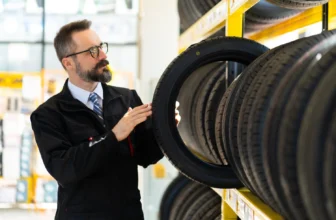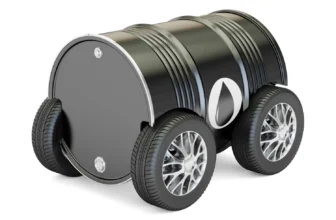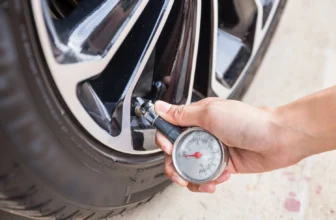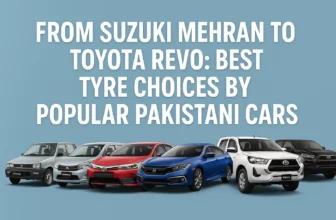
Imported Japanese cars have taken over Pakistan’s roads—and for good reason. They offer superior fuel economy, modern features, and smoother drives compared to most locally assembled options. But one critical flaw often goes unnoticed: tyres. Most of these vehicles arrive with old, mismatched, or undersized tyres that simply aren’t made for Pakistan’s climate or road conditions. Upgrading to the right set of tyres doesn’t just improve comfort—it directly enhances safety, performance, and long-term durability. In this blog, we’ll explore why most Japanese imports need a tyre upgrade, and how choosing wisely can make a measurable difference to your daily driving.
Why Most Imported Cars Come With Poor Tyres
Aged or expired rubber
Most used Japanese cars at auction have been sitting for months, sometimes years, before shipping. Even if the tread looks fine, the rubber may be 5–7 years old and structurally degraded. Old rubber hardens, loses flexibility, and becomes dangerous under high-speed or high-temperature conditions.
Tyres are not a priority for exporters
When vehicles are prepared for auction or export, tyre condition is usually ignored. The focus is on paint, interior, engine, and mileage. Tyres are replaced only if visibly flat or bald—and even then, usually with the cheapest used sets that just barely pass inspection.
Designed for Japanese roads, not Pakistani terrain
Japanese tyres are engineered for city driving on smooth, well-maintained roads. Pakistan’s rough asphalt, potholes, heat, and speed breakers put much more stress on sidewalls and tread. Imported tyres often crack prematurely or deliver a bumpy, noisy ride under local conditions.
Uncommon or unsuitable sizes
Many Japanese models arrive with narrow tyres or unusual size combinations that are hard to find locally. As a result, workshops may install undersized or mismatched alternatives just to make them fit—sacrificing grip, braking performance, and alignment in the process.
How the Wrong Tyres Affect Performance and Safety
Compromised braking and longer stopping distances
Worn-out or hard rubber tyres greatly reduce braking grip—especially in rain or emergency situations. Even with ABS, low-traction tyres can cause your car to slide or take extra metres to stop, putting lives at risk.
Poor handling and steering response
Inappropriate tyres affect how your car responds on turns, corners, and uneven roads. Steering can feel loose, unresponsive, or overly sensitive. You’ll notice more body roll and less control—especially at higher speeds.
Reduced fuel efficiency and increased road noise
Low-quality or mismatched tyres create more rolling resistance, forcing your engine to work harder. That means lower mileage and more noise in the cabin—something most Japanese cars are supposed to excel at.
Faster wear and risk of tyre failure
Old or soft-compound Japanese tyres tend to wear unevenly and develop sidewall cracks under Pakistan’s heat. This increases the risk of tyre bursts or tread separation—especially dangerous on highways or during summer driving.
Best Tyre Sizes for Popular Used Japanese Cars
Why size matters
Getting the right tyre size is more than a cosmetic choice—it affects how your car accelerates, brakes, steers, and handles bumps. Many Japanese imports come with narrow or outdated size configurations, and upgrading to a slightly wider or taller profile can greatly improve road grip and comfort—if done correctly.
Common models and their suggested upgrades
Below is a practical tyre size comparison for some of the most popular Japanese cars in Pakistan. These suggestions offer better grip, smoother ride quality, and compatibility with local road conditions—while staying within the safe rolling diameter range.
| Car Model | OEM Tyre Size | Suggested Upgrade |
|---|---|---|
| Toyota Aqua | 175/65R15 | 185/65R15 |
| Honda Fit | 175/70R14 | 185/65R15 |
| Nissan Note | 165/70R14 | 175/70R14 |
| Toyota Vitz | 165/70R14 | 175/65R14 or 185/60R14 |
| Daihatsu Mira | 145/80R13 | 155/70R13 or 155/80R13 |
Always confirm compatibility with your vehicle’s suspension and wheel well before upsizing.
Should You Upsize? Myths vs Reality
The pros of upsizing
Many car owners opt for upsized tyres because they look sportier and provide better traction. A slightly wider tyre improves cornering grip, reduces braking distance, and gives a more planted feel on rough roads. It also helps when driving with passengers or luggage, especially on highway journeys.
The cons most people ignore
Going too big can backfire. Heavier tyres reduce fuel economy and put extra load on the suspension and steering system. If you exceed the safe diameter range (+/- 2%), your speedometer can become inaccurate, and you may face rubbing or clearance issues on turns or bumps.
The right way to upsize
Use online tools to compare your stock size with the upgrade option and ensure the rolling diameter stays within safe limits. A modest upgrade (one size wider or slightly taller sidewall) usually delivers the best balance between comfort and performance.
Best Tyre Brands for Pakistani Roads (By Budget)
Premium brands for long-term value
If you’re looking for the best in grip, durability, and noise control, brands like Michelin, Yokohama, and Pirelli perform well under Pakistani conditions. They offer excellent wet and dry traction, and last longer—even on rough terrain.
Mid-range options with solid performance
Dunlop, Kumho, and Hankook strike a great balance between price and reliability. These are ideal for city drivers who want improved comfort and handling without going over budget.
Budget-friendly choices that still work
For those looking to keep costs down, brands like General, Panther, or Roadstone provide decent durability and basic road safety. Just make sure you buy fresh stock with a recent manufacturing date.
How climate affects your choice
Drivers in hot areas like Lahore or Multan should prioritise tyres with strong sidewalls and high heat resistance. Coastal areas like Karachi require good wet grip and anti-hydroplaning tread patterns. Northern users may want extra load support for inclines and rugged roads.
Where to Buy Reliable Tyres for Japanese Cars
Avoid used or expired tyres from scrap markets
It’s common to find “almost new” tyres in local tyre shops or car markets, but many of these are actually expired imports or reject stock. These may look fresh but often have compromised rubber quality, poor grip, or even internal damage. Buying such tyres can be a short-term saving but a long-term risk—especially at high speeds or during emergency braking.
Why certified online stores are better
Platforms like TyrePoint.pk allow you to filter by exact tyre size, brand, and budget—without relying on guesswork or verbal assurances from local sellers. You can see clear details like manufacturing date, load index, speed rating, and whether the tyre is suited for urban or highway use. That transparency makes all the difference.
Get the full service, not just the tyre
A good tyre purchase includes proper wheel balancing, valve replacement, and alignment advice. Even if you’re buying online, make sure the seller offers clear guidance or after-sales support. Incorrect fitting can reduce tyre life and waste the benefits of your upgrade.
A Small Change That Delivers a Big Difference
Tyres may seem like a minor detail when buying a used Japanese car, but they have a major impact on your driving experience. The wrong tyres can turn a fuel-efficient, smooth vehicle into a noisy, unstable, and unsafe one. On the other hand, a smart upgrade matched to Pakistan’s road conditions can unlock your car’s full potential—enhancing grip, comfort, safety, and mileage.
If you drive a Vitz, Aqua, Mira, or any other imported model, take a moment to inspect what’s currently on your wheels. A better set of tyres isn’t just an expense—it’s an investment in performance, peace of mind, and long-term value.
For expert recommendations, size compatibility, and top-brand options, explore TyrePoint.pk and get tyres that are truly road-ready for Pakistan.






